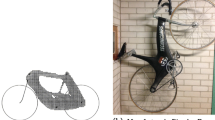Abstract
Topology optimization is used to find a preliminary structural configuration that meets a predefined criterion. It involves optimizing both the external boundary and the distribution of the internal material within a structure. Usually, counters are used a posteriori to the topology optimization to further adapt the shape of the topology according to manufacturing needs. Here we suggest optimizing topologies by evolving counters. We consider both outer and inner counters to allow for holes in the structure. Due to the difficulty of defining a reliable measure for the differences among shapes, little research attention has been focused on simultaneously finding diverse sets of optimal topologies. Here, niching is implemented within a suggested evolutionary algorithm in order to find diverse topologies. The niching is then embedded within the algorithm through the use of our recently introduced partitioning algorithm. For this algorithm to be used, the topologies are represented as functions. Two examples are given to demonstrate the approach. These examples show that the algorithm evolves a set of diverse optimal topologies.
Access this chapter
Tax calculation will be finalised at checkout
Purchases are for personal use only
Preview
Unable to display preview. Download preview PDF.
Similar content being viewed by others
References
Avigad, G., Goldvard, A., Salomon, S.: Partitioning Algorithms. Technical report No. br352012, http://brd.braude.ac.il/~gideon
Conceio, A.: A hierarchical genetic algorithm with age structure for multimodal optimal design of hybrid composites. Structural Multidisciplinary Optimization 31, 280–294 (2006)
Erlbaum, L.: Conference on Genetic Algorithm, pp. 41–49. Associates Inc., Hillsdale (1987)
Glover, F.: Tabu search part I. ORSA Journal on Computing 1(3), 190–206 (1989)
Goldberg, D.E.: Genetic algorithms in search, optimization and machine learning. Addison Wesley, Massachusetts (1989)
Goldberg, D.E., Richardson, J.: Genetic algorithms with sharing for multimodal function optimization. In: Proceedings of the Second International
Hadar, J., Rusell, W.R.: Rules for Ordering Uncertain Prospects. American Economic Review 59, 25–34 (1969)
Holland, J.H.: Adaptation in neural and artificial systems. The University of Michigan Press, Ann Arbor (1975)
Harik, G.R.: Finding multimodal solutions using restricted tournament selection. In: Eshelman, L. (ed.) Sixth International Conference on Genetic Algorithms, pp. 24–31. Morgan Kaufmann, San Francisco (1995)
Jahn, J.: Vector Optimization, Theory, Applications and Extensions, 2nd edn. Springer, Heidelberg (2011)
Jensen, E.D.: Topological structural design using genetic algorithms, Phd. Dissertation, Purdue University, Lafayette (1992)
Li, J.-P., Balazs, M.E., Parks, G.T., Clarkson, P.J.: A species conserving genetic algorithm for multimodal function optimization. Evolutionary Computation 10(3), 207–234 (2002)
Li, J.-P., Li, X.-D., Wood, A.: Species Based Evolutionary Algorithms for Multimodal Optimization. In: A Brief Review, WCCI 2010 IEEE (2010)
Kennedy, J., Eberhart, R.C.: Particle Swarm Optimization. In: IEEE Int.Conf. on Neural Networks, pp. 1942–1948 (1995)
Kicinger, R., Arciszewski, T., De Jong, K.A.: Evolutionary computation and structural design: a survey of the state of the art. Computers and Structures 83(23-24), 1943–1978 (2005)
Kim, I.Y., de Weck, O.L.: Variable chromosome length genetic algorithm for progressive refinement in topology optimization. Structural and Multidisciplinary Optimization 29(6), 445–456 (2005)
Kirk Martini, P.E.: Harmony Search Method for Multimodal Size, Shape, and Topology Optimization of Structural Frameworks. Journal of Structural Engineering 137(11), 1332–1339 (2011)
Mahfoud, S.W.: Crowding and preselection revisited. In: Bnner, R.M., Manderick, B. (eds.) Proceedings of the Second International Conference on Parallel Problem Solving from Nature - PPSN 2011, vol. 36, pp. 27–36. Elsevier Science Publishers (1992)
Mengshoel, O.J., Goldberg, D.E.: The Crowding Approach to Niching in Genetic Algorithm. Evolutionary Computation 16(3), 315–354 (2008)
Rechenberg, I.: Evolutionsstrategie: Optimierung technischer systeme nach prinzipien der biologischen evolution, Stuttgart. Fommann-Holzbook (1973)
Sandgren, E., Jensen, E.D., Welton, J.: Topological design of structural components using genetic optimization methods. In: Proceedings of the Winter Annual Meeting of the American Society of Mechanical Engineers, pp. 31–43 (1990)
Stoean, C., Preuss, M., Stoean, R., Dumitrescu, D.: Disburdening the Species Conservation Evolutionary Algorithm of Arguing with Radii. In: GECCO 2007, pp. 1420–1427 (2007)
Wang, S.Y., Tai, K.: Graph representation for structural topology optimization using genetic algorithms. Computers and Structures 82(2021), 1609–1622 (2004)
Wang, S.Y., Tai, K.: Structural topology design of optimization using genetic algorithm with a bit-array representation. Computer Methods in Applied Mechanics and Engineering 194(3638), 3749–3770 (2005)
Woon, S.Y., Tong, L., Osvaldo, O.M., Steven, G.P.: Effective optimization of continuum topologies through a multi-GA system. Computer Methods in Applied Mechanics and Engineering 194(3033), 3416–3437 (2005)
Li, X.: Adaptively Choosing Neighbourhood Bests Using Species in a Particle Swarm Optimizer for Multimodal Function Optimization. In: Deb, K., Tari, Z. (eds.) GECCO 2004. LNCS, vol. 3102, pp. 105–116. Springer, Heidelberg (2004); Fommann-Holzbook 1973
Author information
Authors and Affiliations
Corresponding author
Editor information
Editors and Affiliations
Rights and permissions
Copyright information
© 2013 Springer-Verlag Berlin Heidelberg
About this paper
Cite this paper
Avigad, G., Matalon Eisenstadt, E., Salomon, S., Gadelha Guimar, F. (2013). Evolution of Contours for Topology Optimization. In: Schütze, O., et al. EVOLVE - A Bridge between Probability, Set Oriented Numerics, and Evolutionary Computation II. Advances in Intelligent Systems and Computing, vol 175. Springer, Berlin, Heidelberg. https://doi.org/10.1007/978-3-642-31519-0_26
Download citation
DOI: https://doi.org/10.1007/978-3-642-31519-0_26
Publisher Name: Springer, Berlin, Heidelberg
Print ISBN: 978-3-642-31518-3
Online ISBN: 978-3-642-31519-0
eBook Packages: EngineeringEngineering (R0)




